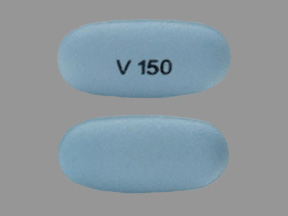Ivacaftor
Generic name: ivacaftor [ EYE-va-KAF-tor ]
Brand name: Kalydeco
Dosage forms: oral granule for reconstitution (13.4 mg; 25 mg; 5.8 mg; 50 mg; 75 mg), oral tablet (150 mg)
Drug class: CFTR potentiators
What is ivacaftor?
Ivacaftor is used to treat cystic fibrosis in adults and children who are at least 1 month old and weigh at least 6 pounds (3 kilograms).
Ivacaftor tablet can be used in children aged 6 years and older. Ivacaftor granules can be used in children aged 1 month to under 6 years old.
Your doctor will make sure you have the specific gene mutation related to cystic fibrosis to be treated with ivacaftor.
Ivacaftor may also be used for purposes not listed in this medication guide.
Ivacaftor side effects
Get emergency medical help if you have signs of an allergic reaction: hives, difficult breathing, swelling of your face, lips, tongue, or throat.
Ivacaftor may cause serious side effects. Call your doctor at once if you have:
-
blurred vision, eye pain or redness, seeing halos around lights;
-
low blood sugar--headache, hunger, weakness, sweating, confusion, irritability, dizziness, fast heart rate, or feeling jittery; or
-
liver problems--loss of appetite, nausea, vomiting, stomach pain (upper right side), tiredness, itching, dark urine, clay-colored stools, jaundice (yellowing of the skin or eyes).
Common side effects of ivacaftor may include:
-
muscle or joint pain;
-
dizziness;
-
rash, acne;
-
headache;
-
mouth pain;
-
stomach pain, nausea, diarrhea; or
-
cold symptoms such as stuffy nose, sneezing, runny nose, sore throat.
This is not a complete list of side effects and others may occur. Call your doctor for medical advice about side effects. You may report side effects to FDA at 1-800-FDA-1088.
Related/similar drugs
Warnings
Use only as directed. Tell your doctor if you use other medicines or have other medical conditions or allergies.
Before taking this medicine
You should not be treated with ivacaftor if you are allergic to it, or if you have or have ever had:
-
liver or kidney disease.
It is not known if ivacaftor will harm an unborn baby. Tell your doctor if you are pregnant or plan to become pregnant.
Ask a doctor if it is safe to breastfeed while using ivacaftor.
How should I take ivacaftor?
Follow all directions on your prescription label and read all medication guides or instruction sheets. Your doctor may occasionally change your dose. Use the medicine exactly as directed.
Take ivacaftor with food that contains fat, such as eggs, milk products such as whole milk, cheese, yogurt, breast milk or infant formula. Follow your doctor's instructions carefully.
Swallow the tablet whole and do not crush, chew, or break it.
Mix the ivacaftor granules with 1 teaspoon of soft food such as pureed fruits or vegetables, yogurt, applesauce, water, breast milk, infant formula, milk, or juice. Mix only 1 dose at a time and use within 1 hour after mixing. Feed the child a high-fat food after or before giving the granule mixture.
Take this medicine at evenly spaced intervals every 12 hours.
Doses are based on weight in children. Your child's dose may change if the child gains or loses weight.
You will need frequent blood tests to check your liver function.
Your child may need frequent vision exams.
Store at room temperature away from moisture and heat. Keep the medicine in the original packaging.
What happens if I miss a dose?
Take the medicine as soon as you can, with a fatty meal, but skip the missed dose if you are more than 6 hours late for the dose. Do not take two doses at one time.
What happens if I overdose?
Seek emergency medical attention or call the Poison Help line at 1-800-222-1222.
What should I avoid while taking ivacaftor?
Avoid driving or hazardous activity until you know how ivacaftor will affect you. Dizziness or drowsiness can cause falls, accidents, or severe injuries.
Grapefruit may interact with ivacaftor and cause side effects. Avoid consuming grapefruit products.
What other drugs will affect ivacaftor?
Sometimes it is not safe to use certain medicines at the same time. Some drugs can affect your blood levels of other drugs you use, which may increase side effects or make the medicines less effective.
Tell your doctor about all your other medicines, especially:
-
seizure medicine such as carbamazepine, phenobarbital, or phenytoin;
-
an antibiotic--clarithromycin, erythromycin, telithromycin, rifabutin, rifampin; or
-
antifungal medicine--fluconazole, itraconazole, ketoconazole, posaconazole, voriconazole.
This list is not complete. Other drugs may affect ivacaftor, including prescription and over-the-counter medicines, vitamins, and herbal products. Not all possible drug interactions are listed here.
Popular FAQ
What is an orphan drug?
Orphan drugs are medicines developed to help treat, prevent or diagnose rare “orphan” diseases, which are conditions that each affect fewer than 200,000 people in the U.S. Continue reading
How does Kalydeco work?
Kalydeco specifically targets the underlying cause of cystic fibrosis (CF) and is approved for adults, children, and infants aged 4 months and older with CF with one or more specific mutations in their CFTR gene that is responsive to Kalydeco. It allows the defective CFTR protein to work better and increases salt and water movement within the airways. This thins the mucus and makes it easier to cough out. Continue reading
More FAQ
- What is the difference between Symdeko and Orkambi?
- What is the difference between Symdeko and Kalydeco?
More about ivacaftor
- Check interactions
- Compare alternatives
- Reviews (1)
- Side effects
- Dosage information
- During pregnancy
- Drug class: CFTR potentiators
- Breastfeeding
Patient resources
Other brands
Professional resources
Other brands
Related treatment guides
Further information
Remember, keep this and all other medicines out of the reach of children, never share your medicines with others, and use this medication only for the indication prescribed.
Always consult your healthcare provider to ensure the information displayed on this page applies to your personal circumstances.
Copyright 1996-2025 Cerner Multum, Inc. Version: 6.01.

